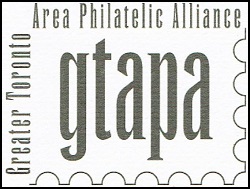
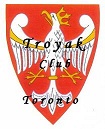
HAPPY CANADA’S 154th BIRTHDAY!
BONNE FÊTE DU CANADA!

CANADA
www.canada.ca
https://en.wikipedia.org/wiki/Canada
Canada is a country in the northern part of North America. Its ten provinces and three territories extend from the Atlantic to the Pacific and northward into the Arctic Ocean, covering 9.98 million square kilometres (3.85 million square miles), making it the world’s second-largest country by total area. Its southern border with the United States, stretching 8,891 kilometres (5,525 mi), is the world’s longest bi-national land border. Canada’s capital is Ottawa, and its three largest metropolitan areas are Toronto, Montreal, and Vancouver. Official languages: English and French. Population: 38 million. Monetary Unit: Canadian Dollar. Nunavut is the newest, largest, and most northerly territory of Canada. It was separated officially from the Northwest Territories on April 1, 1999. Capital: Iqaluit.
![]()
TROYAK EXECUTIVE TEAM is informing all members, colleagues, collectors, and Polonia at large, that Club meetings taking place at John Paul II Polish Cultural Centre, 4300 Cawthra Rd. (just south of Hwy. 403), Mississauga, Ontario. The new members are always welcome. www.polishculturalcentre.ca
ADRES SPOTKAÑ KLUBOWYCH! Zarząd Główny Klubu “Troyak” informuje wszystkich członków kolekcjonerów, sympatyków oraz całą Polonię, że spotkania klubowe odbywają się w Polskim Centrum Kultury im. Jana Pawła II, przy 4300 Cawthra Rd. (na południe od autostrady 403), Mississauga, Ontario. Zapraszamy nowych członków do prężnego. Klubu “Troyak”. www.polishculturalcentre.ca

“TROYAK” CLUB NEXT MEETINGS …
NASTĘPNE SPOTKANIA KLUBU “TROYAK” …

July & August 2021 – Summer break … Letnie wakacje …
25th July 2021 @ 4:30 p.m. … via ZOOM only

26th September 2021 @ 4:30 p.m.
3rd October 2021 @ 9:00 a.m. to 4:00 p.m. …
Mississauga’s 5th Annual Fall Show
31st October 2021 @ 4:30 p.m.
28th November 2021
December 2021 @ Happy Holidays!

100. Rocznica urodzin ks. Franciszka Blachnickiego
100th Anniversary of Fr. Francis Blachnicki Birth
www.poczta-polska.pl
W dniu 24 marca 2021 r. została wprowadzona do obiegu kartka pocztowa z nadrukowanym znakiem opłaty pocztowej, emisji: 100. rocznica urodzin ks. Franciszka Blachnickiego. Wartość nominalna znaku opłaty pocztowej z oznaczeniem literowym A odpowiada wartości nominalnej znaczka pocztowego używanego do uiszczenia opłaty za ekonomiczną przesyłkę listową nierejestrowaną, w tym kartkę pocztową, w obrocie krajowym, w formacie S o masie do 500 g. W prawym górnym rogu strony adresowej kartki nadrukowano znak opłaty pocztowej, na którym umieszczono zdjęcie przedstawiające ks. Franciszka Blachnickiego. Wzdłuż prawej krawędzi znaczka umieszczono napis: POLSKA, a w prawym górnym rogu oznaczenie wartości: A. W części ilustracyjnej kartki znajduje się tytuł emisji ,,100. rocznica urodzin ks. Franciszka Blachnickiego” oraz zdjęcie przedstawiające ks. Franciszka Blachnickiego. Kartki o wymiarach 148 x 105 mm wydrukowano jednostronnie, techniką offsetową, na kartonie białym, w nakładzie 8000 sztuk. Autor projektu kartki: Jan Konarzewski.
Franciszek Blachnicki (ur. 24 marca 1921 w Rybniku, zm. 27 lutego 1987 w Carlsbergu, w RFN) – polski ksiądz katolicki, wykładowca Katolickiego Uniwersytetu Lubelskiego, organizator Krucjaty Wstrzemięźliwości, założyciel Ruchu Światło-Życie, twórca Krucjaty Wyzwolenia Człowieka i Chrześcijańskiej Służby Wyzwolenia Narodów, więzień obozów koncentracyjnych, prześladowany przez Służbę Bezpieczeństwa PRL, Czcigodny Sługa Boży Kościoła katolickiego, założyciel wspólnot życia konsekrowanego: Instytutu Niepokalanej Matki Kościoła, Wspólnoty Chrystusa Sługi oraz Unii Kapłanów Chrystusa Sługi.
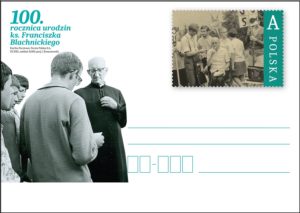
100th Anniversary of Fr. Francis Blachnicki Birth …
denomination: 3,30 PLN ; number of stationeries in set: 1;
print run: 8.000 pcs; printing technique: offset;
card size: 148 x 105 mm; author: Jan Konarzewski;
release date: 24th March 2021.
Franciszek Blachnicki (24 March 1921 – 27 February 1987) was a Polish Roman Catholic priest and the founder of the Light-Life movement – also known as the Oasis Movement – and the Secular Institute of the Immaculate Mother of the Church. He founded several other movements and religious congregations that would address a range of social and ethical issues. These issues included anti-alcoholism and human rights. His movements first came about after starting out as simple retreats designed for both altar servers and families that later began to address a series of issues in Poland at the time. His concern for human rights came during the communist era in Poland as well as his experiences as a prisoner of war during World War II in which he was incarcerated in Auschwitz and other concentration camps under the German Nazi regime. Blachnicki’s beatification process opened in Poland in the 1990s and he became titled as a Servant of God upon the cause’s commencement. The decisive moment in the process came on 30 September 2015 after Pope Francis confirmed his heroic virtue and titled him as Venerable.

Polacy ratujący Żydów
Poles rescuing Jews
www.poczta-polska.pl
W dniu 24 marca 2021 r. został wprowadzony do obiegu znaczek pocztowy o wartości 3,30 zł emisji “Polacy ratujący Żydów”. Na znaczku przedstawiono zdjęcie pomnika autorstwa Moniki Kupiec, znajdującego się w Popardowej gm. Nawojowa, upamiętniającego wydarzenia z marca 1944 r., przedstawiającego kontury sylwetek czwórki Polaków zasłaniających sobą sześcioro Żydów. W lewym dolnym rogu znaczka umieszczono napis Polska oraz oznaczenie wartości 3,30 zł, natomiast wzdłuż górnej krawędzi – Polacy ratujący Żydów oraz umieszczono nazwiska czterech Polaków: Agnieszka Rumin, Jan Rumin, Jakub Tokarz i Ludwik Borek. Na kopercie przedstawiono zdjęcie tablicy informacyjnej dotyczącej Pamięci polskich i żydowskich obywateli Rzeczypospolitej Mieszkańców Gminy Nawojowa i Kamionka Wielka zamordowanych przez Niemców. Znaczek wydrukowano techniką rotograwiurą, na papierze fluorescencyjnym, w formacie znaczka 39,5 mm x 31,25 mm, w nakładzie 100.000 sztuk. Arkusz sprzedażny zawiera 50 znaczków. Z tej okazji została wydana również koperta FDC. Autor projektu znaczka: Jacek Konarzewski. Autor projektu koperty i datownika FDC: Jan Konarzewski.

Poles rescuing Jews … denomination: 3,30 PLN;
number of stamps in set: 1; print run: 100.000 pcs.;
printing techniques: rotogravure; paper: fluorescent;
stamp size: 39,5 mm x 31,25 mm; 50 stamps in sheet;
number of FDC: 1; designer of the stamp: Jacek Konarzewski;
designer of the FDC and the postmark: Jan Konarzewski;
circulation date: 24th March 2021.
W 2018 roku Poczta wprowadziła do obiegu pierwszy znaczek z serii honorującej Polaków, którzy ratowali Żydów. Walor przypominał historię rodziny Ulmów, która podczas okupacji dała schronienie ośmiorgu Żydów. W tym samym roku Spółka wydała również kartkę upamiętniającą postać siostry Matyldy Getter. W 2019 roku w ręce klientów i filatelistów trafiło kolejne wydawnictwo serii. Prezentowało Edwarda Raczyńskiego – ówczesnego ministra sprawa zagranicznych Rządu RP na uchodźctwie, którego nota była pierwszym oficjalnym raportem o holokauście informującym zachodnią opinię publiczną o zbrodniach. Było to również pierwsze oficjalne wystąpienie jednego z rządów w obronie wszystkich Żydów prześladowanych przez hitlerowskie Niemcy – nie tylko obywateli swego kraju.

Jerzy Iwanow-Szajnowicz
www.poczta-polska.pl
W dniu 25 marca 2021 r. został wprowadzony do obiegu znaczek pocztowy o wartości 8,00 zł emisji “Jerzy Iwanow-Szajnowicz”. Na znaczku przedstawiono koloryzowane zdjęcie Szajnowicza na krótko przed rozpoczęciem wojny 1939 r, na tle flag Polski i Grecji. Wzdłuż dolnej krawędzi znaczka umieszczono tytuł emisji: Jerzy Iwanow-Szajnowicz, natomiast w górnym rogu znaczka napis Polska oraz oznaczenie wartości 8 zł. W datowniku postać Jerzego – Iwanowa Szajnowicza, na kopercie przedstawiono przedmioty związane z działalnością agenta i dywersją. Znaczek wydrukowano techniką rotograwiurową, na papierze fluorescencyjnym, w formacie 31,25 x 25,5 mm, w nakładzie 10 000 000 sztuk. Arkusz sprzedażny zawiera 100 szt. znaczków. Z tej okazji została wydana również koperta FDC. Autor projektu: Agnieszka Sancewicz.
Poczta Polska wprowadziła do obiegu znaczek emisji „Jerzy Iwanow-Szajnowicz”. Walor, prezentujący sylwetkę jednego z najskuteczniejszych sabotażystów okresu II wojny światowej, trafił do placówek pocztowych w całym kraju. 25 marca 2021 r. przypada dwusetna rocznica rozpoczęcia greckiej walki o niepodległość. Grecja świętuje ten kamień milowy, który dał początek nowoczesnemu państwu greckiemu jak również zapoczątkował nową erę dla Europy i całego regionu.
– Znaczek okolicznościowy Poczty Polskiej przedstawiający bohatera dwóch narodów, Jerzego Iwanowa-Szajnowicza mówi sam za siebie. Jego słowa wypowiedziane w chwili egzekucji: „Niech żyje Grecja, niech żyje Polska” na zawsze pozostaną w naszej pamięci. Mamy nadzieję, że wirtualna prezentacja znaczka, wynikająca ze względów pandemicznych, zostanie zastąpiona bezpośrednią formą kontaktu. Pozwoli to realizację kontaktów dwustronnych na wysokim szczeblu tak, jak to miało miejsce w przeszłości – powiedział Michael-Efstratios C. Daratzikis, ambasador Grecji w Polsce.
Autorka projektu znaczka, Agnieszka Sancewicz, przedstawiła na znaczku fotografię ukazującą Jerzego Iwanowa-Szajnowicza na chwilę przed rozpoczęciem II wojny światowej. Zdjęcie, poddane koloryzacji przez Mirosława Szponara, pochodzi ze zbiorów rodzinnych Leonardy Lambrianidu, bratanicy Iwanowa-Szajnowicza. Oprócz znaczka Poczta Polska wydała, w limitowanej wersji, kopertę FDC, czyli kopertę Pierwszego Dnia Obiegu. Przedstawia ona przedmioty związane z działalnością wywiadowczą i dywersją.
– Wydając znaczki pocztowe Spółka pragnie nie tylko skupiać na wartościach estetycznych swoich wydawnictw i dostarczać odbiorcom piękne walory. Przede wszystkim pragniemy wykorzystywać wielką moc filatelistyki i przypominać za jej pośrednictwem o najważniejszych postaciach i wydarzeniach w dziejach Polski, Europy i Świata. Szczególnie ważne staje się to w sytuacji kiedy mowa o zapomnianych bohaterach historii. Do takich na pewno należał, uwieczniony na najnowszym znaczku Poczty Polskiej, agent służb specjalnych, Jerzy Iwanow-Szajnowicz. Zdaniem historyków, jego popularność jest niewspółmierna do skali jego wyczynów, bo choć nie miał do dyspozycji ani jednego żołnierza, a wyłącznie swój wrodzony talent, jest oceniany jako najskuteczniejszy sabotażysta w dziejach wywiadu – powiedział Tomasz Zdzikot, prezes zarządu Poczty Polskiej.
Jerzy Iwanow-Szajnowicz był wybitnym agentem polskich i brytyjskich służb specjalnych oraz zasłużonym działaczem greckiego ruchu oporu. Zdaniem wielu specjalistów był on najskuteczniejszym sabotażystą, jakim alianci dysponowali w całym okresie II wojny światowej. Pośmiertnie został odznaczony Srebrnym Krzyżem Orderu Virtuti Militari, Krzyżem Męstwa – najwyższe odznaczenie wojenne Królestwa Grecji i drugie w hierarchii odznaczenie wojenne Republiki Greckiej oraz Krzyżem Jerzego – najwyższe cywilne odznaczenie państwowe Zjednoczonego Królestwa. Iwanow-Szajnowicz był również zdolnym sportowcem (piłka nożna, piłka wodna, pływanie i żeglarstwo).
– Serdecznie dziękuję za to, że Poczta Polska, włączając się w świętowanie jubileuszu 200-lecia greckiej niepodległości, podjęła inicjatywę, która wyszła ze strony naszej grupy parlamentarnej i upamiętniła z tej okazji postać szczególnego Bohatera Narodów. „Niech żyje Grecja, niech żyje Polska!” – słowa wykrzyczane przez Szajnowicza w chwili, gdy stał przed niemieckim plutonem egzekucyjnym, do dziś stanowią fundament głębokiego szacunku obecnego w naszych bilateralnych relacjach – powiedział poseł Daniel Milewski, przewodniczący Polsko-Greckiej Grupy Parlamentarnej.
– Spełniając swoją edukacyjną misję, Poczta Polska najnowszym znaczkiem obiegowym przybliża postać bohatera Polski i Grecji, o którego zaletach, umiejętnościach i dokonaniach można mówić wiele. Poliglota, znakomity sportowiec, polski harcerz, agent polskich oraz brytyjskich służb specjalnych i bohater greckiego ruchu oporu. Przez wielu nazywany polskim Jamesem Bondem, swoim heroizmem udowodnił, że dla wolności warto poświęcić nawet życie. Grecy widzą w nim przykład zaangażowania Polaków w walkę o grecką wolność, a my naszą emisją oddajemy również hołd tym, którzy 200 lat temu walczyli o grecką niepodległość – powiedział Wiesław Włodek, wiceprezes zarządu Poczty Polskiej. W kwietniu 2019 roku Spółka wprowadziła do obiegu znaczek pocztowy emisji „100. rocznica nawiązania polsko-greckich relacji dyplomatycznych”.
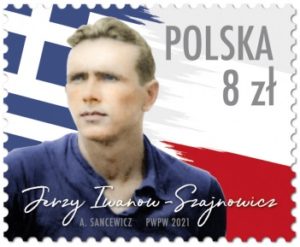
Jerzy Iwanow-Szajnowicz … denomination: 8,00 PLN;
number of stamps in set: 1 (100 pcs in sheet);
printing techniques: photogravure; paper: fluorescent;
print run: 10 000 000 pcs.; stamp size: 31,25 x 25,5 mm;
number of FDC: 1; author: Agnieszka Sancewicz;
circulation date: 25th March 2021.
Jerzy Iwanow-Szajnowicz was born in Warsaw on 14 December 1911, as the son of the Russian army colonel Count Vladimir Ivanov, and a Polish mother. His parents divorced soon after. His mother married a Greek, Ioannis Lambrinidis, and together they emigrated to Thessaloniki in northern Greece in 1926.
He became an athlete in the G.S. Iraklis Thessaloniki sports club, and a distinguished swimmer: in 1934, he became Greek champion in 100 m freestyle. After becoming a Polish citizen in 1935, he became part of AZS Warsaw’s water polo team and of the Polish national water polo team and was declared Poland’s top water polo player in 1938. Iwanow also graduated from the University of Louvain in agricultural engineering, followed by post-graduate courses at the École Nationale supérieure d’agriculture coloniale in Paris, before returning to Greece.
With the outbreak of World War II and the German invasion of Poland, he helped to organize the evacuation of Polish refugees coming to Thessaloniki, and in 1940 was enlisted into Polish intelligence. Fleeing the German invasion of Greece in April 1941, he left the country for the Middle East, to join the exiled Polish forces there. There he was chosen by the Polish intelligence and the SOE for an undercover mission in Greece. On 13 October 1941, the British submarine HMS Thunderbolt (N25) brought him to the coast of Attica near Nea Makri. His subsequent activity in the Greek underground was prodigious: apart from establishing an extensive intelligence network for the Allies reporting on the military and political situation in Greece, on the Greek war industry, now used by the Germans, and on the ship and railway schedules, he engaged in numerous sabotage missions. He was responsible for the sabotage of the German aircraft motor repair facilities in the Maltsiniotis plant, which is credited with affecting over 400 engines and causing the crash of several German aircraft due to engine malfunctions, as well as the destruction of two German U-boats, U-133 and U-372, sabotaging the latter and forcing it to surface and be sunk by the RAF off Haifa.
The first time he was caught by the Gestapo, after being betrayed by one of his associates, Konstantinos Pantos, he managed to escape after three days. The Germans then put a reward on him of 500,000 drachmas. He was finally captured after another betrayal on 8 September 1942 and sentenced by a German tribunal on 2 December to a triple death sentence. The proposal of a spy exchange for the captured by British German General was rejected by the British authorities. He was executed at the Kaisariani shooting range on 4 January 1943. The seconds before execution he attempted to escape. He was just a few meters from the hiding bush when he was shoot wounded and put back in front of the execution squadron by the Germans.

Michał Jankowski (1842-1912)
www.poczta-polska.pl
W dniu 25 marca 2021 r. został wprowadzony do obiegu znaczek pocztowy o wartości 1,00 zł emisji “Michał Jankowski (1842-1912)”. Na znaczku przedstawiono zdjęcie Michała Jankowskiego – uczestnika powstania styczniowego, zesłańca na Syberię, przyrodnika, hodowcy i przedsiębiorcy; z lewej strony widoczny zarys mapy Kraju Nadmorskiego (najbardziej wysuniętej na wschód części Federacji Rosyjskiej) z widocznym Półwyspem Jankowskiego. Na kopercie FDC pomnik Michała Jankowskiego, znajdujący się w dawnym miejscu jego zamieszkania, gdzie założył hodowlę jeleni i koni – obecna nazwa Bezwierchowo (dawne Sidemi), na Półwyspie Jankowskiego oraz tablica informacyjna z pomnika i tłumaczenie napisu “Był szlachcicem w Polsce, zesłańcem na Syberii, dom i sławę znalazł w Kraju Ussuryjskim. To co zebrał niech będzie przykładem dla przyszłych gospodarzy tej ziemi.” Na datowniku emblemat stadniny Jankowskiego: wpisana w podkowę rosyjska litera JA – skrót od nazwiska. Znaczek wydrukowano techniką rotograwiurową, na papierze fluorescencyjnym, w formacie 31,25 x 25,5 mm, w nakładzie 10 000 000 sztuk. Arkusz sprzedażny zawiera 100 szt. znaczków. Z tej okazji została wydana również koperta FDC. Autor projektu: Jan Konarzewski.
Poczta Polska wprowadziła do obiegu znaczek obiegowy emisji „Michał Jankowski (1842–1912)”… Najnowszy walor filatelistyczny, wydany w nakładzie 10 mln egzemplarzy, trafi do placówek pocztowych w całym kraju i bez wątpienia przyczyni się do popularyzacji historii wybitnego polskiego badacza rosyjskiego Dalekiego Wschodu.
Autor projektu, Jan Konarzewski, przedstawił na znaczku zdjęcie Michała Jankowskiego oraz zarys mapy Kraju Nadmorskiego (najbardziej wysuniętej na wschód części Federacji Rosyjskiej) z widocznym Półwyspem zawdzięczającym swoją nazwę nazwisku bohatera najnowszego wydawnictwa filatelistycznego Spółki. Oprócz znaczka Poczta Polska wydała, w limitowanej wersji, kopertę FDC, czyli kopertę Pierwszego Dnia Obiegu. Przedstawia ona pomnik Michała Jankowskiego, znajdujący się w dawnym miejscu jego zamieszkania, gdzie założył hodowlę jeleni i koni oraz tablicę informacyjną z monumentu i tłumaczenie napisu: Był szlachcicem w Polsce, zesłańcem na Syberii, dom i sławę znalazł w Kraju Ussuryjskim. To co zebrał niech będzie przykładem dla przyszłych gospodarzy tej ziemi.
– Najnowszy znaczek obiegowy Poczty Polskiej prezentuje naszego kolejnego wybitnego rodaka Michała Jankowskiego, który za walkę o wolność i niepodległość Polski został zesłany na Syberię. Jest on jedną z najciekawszych postaci w historii Dalekiego Wschodu, charakteryzującą się niespotykaną, prawdziwą pasją odkrywcy, a jednocześnie prawie nieznaną w Polsce. Wydawnictwo filatelistyczne upamiętniające wybitnego naukowca i przedsiębiorcę powstało w ścisłej współpracy z Ministerstwem Spraw Zagranicznych i wpisuje się w promowanie wiedzy o tych powszechnie znanych i nieznanych jeszcze Polakach, którzy swoje życie, nie z własnego wyboru, wiedli poza Polską, a w przypadku Jankowskiego – na dalekiej Syberii – powiedział wiceprezes Poczty Polskiej Wiesław Włodek.
Michał Jankowski, żyjący w latach 1842–1912, był wybitnym pionierem rosyjskiego Dalekiego Wschodu. Za udział w powstaniu styczniowym został zesłany na Syberię, gdzie po odbyciu kary osiedlił się na stałe. Założył pierwszą w carskiej Rosji plantację żeń-szenia oraz prowadził hodowlę koni i jeleni wschodnich. Jego imieniem, jako odkrywcy, nazwano kilka gatunków ptaków, motyli, szczyt górski, a nawet sam półwysep Sidemi nad Morzem Japońskim – obecnie Półwysep Jankowskiego.
15 września 1991 roku – w 150. rocznicę urodzin Michała Jankowskiego – na półwyspie jego imienia, w okolicach Władywostoku, odsłonięto pomnik na cześć zasłużonego Polaka. Pamięć o rodzinie Jankowskich jest tam starannie pielęgnowana.
W 2018 roku Poczta Polska wprowadziła do obiegu znaczek pocztowy emisji „Polacy na Syberii”. Wydawnictwo upamiętniało postać Wacława Sieroszewskiego – działacza niepodległościowego, zesłańca, badacza dalekich kultur i narodów, a także pisarza i odznaczonego Krzyżem Virtuti Militari V kl. senatora Rzeczypospolitej. Znaczek poświęcony M. Jankowskiemu wpisuje się tematyką w powyższą serię.
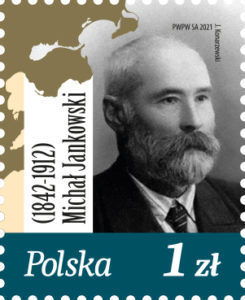
Michał Jankowski (1842-1912) … denomination: 1,00 PLN;
number of stamps in set: 1 (100 pcs in sheet)
print run: 10 000 000 pcs.; stamp size: 31,25 x 25,5 mm;
printing techniques: photogravure; paper: fluorescent;
number of FDC: 1; author: Jan Konarzewski;
circulation date: 25th March 2021.
Michał Jankowski or Mikhail Ivanovich Yankovsky (September 24, 1842 – October 10, 1912) was a Polish Szlachta nobleman who settled in the Russian Far East after serving a sentence in Siberia for participating in the January Uprising of 1863. After being released in 1868 he settled in the Russian Far-East in Sidemi, Primorsky Krai, in a region now known as the Yankovsky Peninsula where he established a horse-breeding farm, reared deer for their antlers, established ginseng plantations, and became a well-known hunter and naturalist. He collected specimens of fauna and flora for museums and collectors and many species were named after him including Jankowski’s bunting.

Nowoczesny tabor kolejowy
Modern rolling stock
www.poczta-polska.pl
W dniu 31 marca 2021 został wprowadzony do obiegu znaczek pocztowy o wartości 3,30 zł, emisji “Nowoczesny tabor kolejowy”. W ramach emisji wydajemy 5 znaczków pocztowych prezentujących modele nowoczesnych pojazdów szynowych wykorzystywanych przez przewoźników w Polsce, tj. Pendolino, Dart, Impuls, Flirt, Elf II. Na przywieszce przedstawiono lokomotywę parową Pt31 64. Emisja “Nowoczesny tabor kolejowy” wpisuje się w obchody Europejskiego Roku Kolei 2021, ustanowionego przez Komisję Europejską. Krajowym koordynatorem Europejskiego Roku Kolei 2021 jest Prezes Urzędu Transportu Kolejowego. Emisja powstała przy ścisłej współpracy z Urzędem Transportu Kolejowego.
Znaczek wydrukowano techniką offsetową, na papierze fluorescencyjnym, format znaczka: 76,5 x 31,25 mm, w nakładzie w wersji perforowanej: 125 000 szt. i nakładzie w wersji nieperforowanej: 10 000 szt. Formą sprzedaży jest blok: 5 znaczków + przywieszka. W ramach emisji wydane zostały 3 koperty pierwszego dnia obiegu FDC, których grafika nawiązuje do: *** o mostu kolejowego nad Notecią; *** o wiszącego mostu w Srebrnej Górze na Dolnym Śląsku; *** o wiaduktu kolejowego w Lewinie Kłodzkim. Autor projektu: Jan Konarzewski. Od 31 marca 2021 r. w ofercie sklepu internetowego oraz w sieci stacjonarnych sklepów filatelistycznych, obok podstawowej formy wydawniczej, jest dostępne limitowane wydanie bloków nieperforowanych emisji ,,Nowoczesny tabor kolejowy”. Wydanie to jest dostępne w sprzedaży jedynie w folderze filatelistycznym, wydanym w nakładzie 10 000 szt.

Modern rolling stock … denomination: 3,30 PLN; number of stamps in set: 5 and label; print run: 125 000 pcs perforated; print run: 10 000 pcs non-perforated; printing techniques: offset; paper: fluorescent; stamp size: 76,5 x 31,25 mm; number of FDC: 3; author: Jan Konarzewski; circulation date: 31st March 2021. From 31 March 2021, a limited edition of unperforated blocks of the “Modern Railway Rolling Stock” issue is available in the offer of the online store and in the network of stationary philatelic stores, in addition to the basic publishing form. This issue is available for sale only in a philatelic folder, issued in an edition of 10,000 pieces.
Najnowsza emisja Poczty Polskiej jest odpowiedzią na zgłaszane przez filatelistów zapotrzebowanie na tematykę kolejnictwa. Jest również wyśmienitą okazją do promowania ekologicznych środków transportu. Hasło „Zielona Poczta” to jeden z kluczowych celów zawartych w najnowszej strategii Spółki.
Inicjatorem projektu ERK2021 jest Komisja Europejska. Przez cały rok 2021 odbywać się będą liczne imprezy związane z transportem kolejowym, których celem będzie zwiększenie znaczenia kolejnictwa i promowanie go jako inteligentnego i ekologicznego środka przemieszczania się. Koordynatorem krajowych wydarzeń z tym związanych jest Prezes Urzędu Transportu Kolejowego, z którym Poczta Polska współpracowała przy realizacji najnowszej emisji. W poniedziałek, 29 marca 2021 oficjalnie Rok Kolei rozpoczęła Komisja Europejska i prezydencja portugalska. W Polsce symbolicznym rozpoczęciem Roku Kolei jest start emisji znaczków z nowoczesnym taborem.
– Cieszę się, że udało nam się zachęcić Pocztę Polską do emisji tej serii znaczków. Kolej jest ważnym elementem życia i gospodarki każdego kraju. Jej potencjał i ekologiczny charakter warto podkreślać na każdym kroku. Europejski Rok Kolei jest impulsem do szerokiej promocji transportu kolejowego jako bezpiecznego, proekologicznego i łączącego ludzi i regiony środka transportu – podsumował start emisji dr inż. Ignacy Góry, Prezes Urzędu Transportu Kolejowego.
Dodatkową atrakcją związaną z najnowszą serią jest to, że oprócz standardowych znaczków, posiadających perforację (po 125 tys. sztuk każdego), Poczta Polska wprowadziła do obiegu walory nieperforowane (po 10 tys. sztuk każdego), co stanowić będzie rarytas dla kolekcjonerów. To nie pierwsze wydawnictwo Poczty Polskiej związane z koleją. W 2018 r. Spółka wydała znaczki pocztowe emisji „100 lat parowozowni w Kędzierzynie-Koźle”, przedstawiające lokomotywy serii Ty42–107 oraz serii TKt48.

Poczta Polska dla kibiców
www.poczta-polska.pl
Polska reprezentacja piłkarska rozpoczęła grę na EURO 2020. Poczta Polska deklaruje, że jest gotowa na emocje sportowe. Specjalnie na to wydarzenie przygotowała biało-czerwoną ofertę kibicowską, dostępną w szerokiej sieci placówek. Spółka po 5 miesiącach tego roku zanotowała wzrost przychodów ze sprzedaży towarów handlowych w placówkach pocztowych o 15 proc. rok do roku.
Briefing prasowy „Poczta Polska dla kibiców” odbył się 14 czerwca br. w siedzibie Poczty Polskiej w Warszawie. W spotkaniu udział wzięli: Jan Tomaszewski, legendarny bramkarz reprezentacji, który w 1973 roku zatrzymał Anglię, Marek Matuszewski, poseł na Sejm RP i p.o. przewodniczącego stałej Komisji Sejmowej Kultury Fizycznej, Sportu i Turystyki oraz prezes zarządu Poczty Polskiej S.A. Tomasz Zdzikot i wiceprezes zarządu PP Andrzej Bodziony.
– Bardzo się cieszę, że Poczta Polska promuje EURO 2020 i to jest bardzo ważne. Wszyscy liczymy na naszą drużynę, bo jak wiadomo „piłka jest okrągła a bramki są dwie”. Zawsze jest zatem szansa na wygraną, dlatego trzymamy kciuki za piękny wynik Polaków. Chciałbym powiedzieć tutaj także o tym, że sport jest także ważny w programie Polski Ład. Zakłada on ponad 300 nowych boisk w różnych gminach, gdzie dotąd ich nie było. Ponad 3600 boisk będzie także poddanych renowacji, bo chcemy, aby jak najwięcej młodych i starszych sportowców miało dobre warunki do uprawiania sportu – powiedział Marek Matuszewski.
– Poczta Polska wspaniale promuje sport wśród polskiego narodu. To szczególnie ważne, by sport promować wśród młodzieży. Nie ma sportu bez kibiców. Mówi się wręcz, że kibice są dwunastym zawodnikiem każdej reprezentacji – powiedział Jan Tomaszewski. – Korzystając z okazji, że stoję tu dziś na tle znaczka pana Kazimierza Górskiego wydanego przez Pocztę, chciałbym przypomnieć o inicjatywnie nadania Stadionowi Narodowemu w Warszawie imienia tego słynnego trenera, który dla mnie osobiście był papieżem polskiej piłki i który udowodnił „że Polacy nie gęsi i swój futbol i swoich futbolistów mają” – podkreślił.

W wyjątkowo emocjonującym okresie EURO 2020 Poczta Polska zaprasza do wspierania naszych piłkarzy i kibicowania narodowej drużynie. Spółka od lat promuje i aktywnie wspiera polski sport. Regularnie wprowadza do obiegu emisje znaczków z wybitnymi postaciami ze świata sportu narodowego. W 2021 roku Poczta Polska oddała w ręce klientów i filatelistów znaczek obiegowy emisji „Kazimierz Górski”. Natomiast postać Kazimierza Deyny znalazła się na obiegowej edycji znaczków Poczty Polskiej w 2019 roku. Znaczek z największą obecną gwiazdą polskiego futbolu – Robertem Lewandowskim – został wprowadzony w 2018 roku. Poczta upamiętnia także wydarzenia sportowe. W maju emisją filatelistyczną uhonorowano Drużynowe Mistrzostwa Europy w Lekkoatletyce Silesia 2021, na których polscy sportowcy zdobyli złoty medal.
– Poczta Polska od lat bardzo aktywnie wspiera sport. Robimy to w sposób właściwy dla naszej firmy. Po pierwsze wykorzystując do tego celu emisje filatelistyczne. Spółka propaguje aktywność sportową także na inne sposoby. Jesteśmy m.in. jednym z głównych partnerów reprezentacji Polski w Amp Futbolu, która święci ogromne tryumfy – powiedział Tomasz Zdzikot, prezes zarządu Poczty Polskiej S.A. – Chcielibyśmy, aby placówki pocztowe były miejscem pierwszego wyboru dla każdego kibica, który poszukuje produktów związanych z aktualnymi wydarzeniami sportowymi. Od dziś w placówkach naszej firmy na terenie kraju dostępna jest specjalna kolekcja akcesoriów kibicowskich. Mocno trzymamy kciuki za biało-czerwonych i tu w tym miejscu mogę zadeklarować, że jeśli polscy piłkarze zdobędą medal, Poczta uhonoruje ich z tej okazji specjalnym znaczkiem – dodał prezes Poczty.
W tym roku ukażą się emisje filatelistyczne poświęcone bieżącym wydarzeniom sportowym: w lipcu będą to „Igrzyska XXXII Olimpiady TOKIO 2020 oraz „XVI Letnie Igrzyska Paraolimpijskie TOKIO 2020”, a we wrześniu znaczkiem pocztowym zostaną uhonorowane „Mistrzostwa Europy Amp Futbol Kraków 2021”. Do obiegu zostanie także wprowadzony znaczek okolicznościowy z okazji przypadającego w tym roku 100-lecia klubu Polonia Warszawa.
Oferta związana z wydarzeniami sportowymi jest dostępna w placówkach pocztowych. Akcja akcentująca elementy patriotyczno-sportowe będzie trwać do 13 sierpnia br. Obejmuje nie tylko produkty związane z EURO 2020, ale także z Letnimi Igrzyskami Olimpijskimi Tokio 2020. Poczta, oprócz bogatej oferty flag i koszulek, oferuje szeroką paletę dedykowanych artykułów i gry planszowe.
– Rosnące zainteresowanie ofertą usług bankowych i ubezpieczeniowych oraz ofertą towarów dystrybuowanych poprzez sieć placówek, znajdujące bezpośrednie odzwierciedlenie w wynikach sprzedażowych Poczty. To strategiczny krok w kierunku podnoszenia rentowności urzędów pocztowych. Chcemy, aby w placówkach były dostępne zawsze prasa i książki, artykuły biurowe, ale także sezonowe, jak flagi przed świętami państwowymi. Teraz wzbogacamy ofertę specjalnie dla kibiców sportowych – powiedział Andrzej Bodziony, wiceprezes zarządu Poczty Polskiej S.A.
Dostosowanie oferty sprzedażowej placówek nie tylko do sezonowych potrzeb klientów, ale także do bieżących wydarzeń sportowych i kulturalnych to jeden z elementów strategii sprzedażowej Spółki. Poczta Polska zanotowała wysoki wzrost sprzedaży asortymentu dostępnego w swoich placówkach. Po 5 miesiącach tego roku widać, że oferta przypadła do gustu klientom. Spółka zanotował wzrost przychodów z tego tytułu o 15 % w stosunku do analogicznego okresu roku 2020. Największe wzrosty w tym okresie Poczta zanotowała w sprzedaży gier i zabawek dla dzieci (o 60%), książek i kolorowanek dla dzieci (o 50%). Większym zainteresowaniem cieszyły się także karty i karnety wielkanocne, słodycze i napoje.

100. Rocznica III Powstania Śląskiego
www.nbp.pl
Narodowy Bank Polski jest centralnym bankiem państwa odpowiadającym za politykę pieniężną i stabilność cen. Jego funkcje określa Konstytucja Rzeczypospolitej Polskiej i ustawa o NBP. NBP ma wyłączne prawo emisji pieniądza. Jako bank centralny nie prowadzi rachunków bankowych obywateli, nie przyjmuje od nich lokat, nie udziela kredytów. Prowadzi natomiast obsługę budżetu państwa, a także podmiotów sektora finansów publicznych. Gromadzi rezerwy walutowe państwa i zarządza nimi. Pełni funkcję banku banków, tworząc warunki do działania systemu bankowego. Jest również jednym z najważniejszych ośrodków naukowo-analitycznych w dziedzinie ekonomii i rynków finansowych. 15 kwietnia 2021 roku Narodowy Bank Polski wprowadził do obiegu złotą monetę o nominale 200 zł oraz srebrną monetę o nominale 10 zł „100. rocznica III Powstania Śląskiego”.
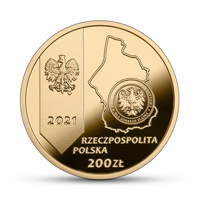
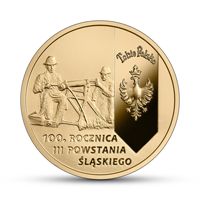
Nominał 200 zł … metal: Au 900/1000; stempel: lustrzany;
średnica: 27,00 mm; masa: 15,50 g; brzeg (bok): gładki;
nakład: do 1500 szt.
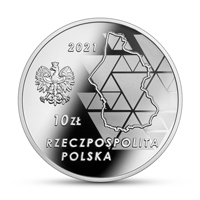
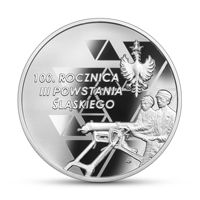
Nominał 10 zł … metal: Ag 925/1000; stempel: lustrzany;
średnica: 32,00 mm; masa: 14,14 g; brzeg (bok): gładki;
nakład: do 12 000 szt.; Projektant: Sebastian Mikołajczak;
Emitent: NBP; Na zlecenie NBP monety wyprodukowała
Mennica Polska S.A.
III Powstanie Śląskie wybuchło w nocy z 2 na 3 maja 1921 r. i było reakcją na wieść o planowanym przyznaniu Niemcom większości uprzemysłowionej części Górnego Śląska. Zostało ono poprzedzone strajkiem powszechnym, który objął 97% zakładów przemysłowych. Działaniami powstańców kierował Wojciech Korfanty, który obwołał się dyktatorem III Powstania Śląskiego. Według historyków do kulminacyjnej bitwy doszło w rejonie Góry Świętej Anny w dniach od 21 do 26 maja 1921 r. Została ona w końcu zajęta przez Niemców. Powstańcom udało się jednak utrzymać front, a ponadto 23 maja 1921 r. wygrać bitwę pod Olzą. 5 lipca 1921 r., po kilkudniowych negocjacjach strony konfliktu zawarły rozejm. Rozpoczęły się kolejne, długie negocjacje w sprawie granic i dopiero w październiku 1921 r. decyzją Rady Ligi Narodów oraz Rady Ambasadorów doszło do finalnego podziału obszaru plebiscytowego. Polska otrzymała mniejszy obszar, ale bardziej uprzemysłowiony. Podział ten był bardziej korzystny dla Polski niż proponowany przed wybuchem III Powstania Śląskiego. 15 maja 1922 r. podpisano w Genewie konwencję, na mocy której uregulowano sprawy gospodarcze oraz prawa mniejszości po obu stronach granicy. W następnych miesiącach Polska przejęła przyznany jej obszar Górnego Śląska.
III Powstanie Śląskie wpisuje się w nurt polskich powstań narodowych. Umożliwiło ono powrót części Górnego Śląska do macierzy, a jego potencjał gospodarczy odegrał bardzo ważną rolę w odbudowie i rozwoju reszty ziem polskich. Ślązacy uzyskali natomiast w dużej mierze możliwości rozwoju swojej kultury i awansu społecznego w wolnej Polsce. Moneta srebrna przedstawia dwóch powstańców obsługujących zdobyczny niemiecki ciężki karabin maszynowy Maxim wz. 1908. Są oni w ubraniach cywilnych, jak większość powstańców. Nad nimi umieszczono orła powstańczego, który był malowany na większości sztandarów w czasie III Powstania Śląskiego.
Na monecie złotej umieszczono sylwetki dwóch powstańców, którzy obsługują zdobyczny niemiecki ciężki karabin maszynowy Maxim wz. 1908. Obok zaprezentowano sztandar powstańczy z napisem „Tobie Polsko” i wizerunkiem orła powstańczego. Wykonano go na początku 1920 r. w pracowni przy redakcji pisma „Katolik” w Bytomiu. Sztandar ten ukrywał przez lata uczestnik trzech powstań śląskich Alojzy Szulc, który w maju 1968 r. sprzedał go do Muzeum Czynu Powstańczego na Górze Świętej Anny, gdzie jest jednym z najcenniejszych eksponatów. Informacja: prof. dr hab. Zygmunt Woźniczka.

100th Anniversary of the 3rd Silesian Uprising
www.nbp.pl
Narodowy Bank Polski is the central bank of the State, responsible for its monetary policy and price stability. The Bank’s functions are described in the Constitution of the Republic of Poland and the Act on NBP. NBP holds the exclusive right to issue the currency of the Republic of Poland. As the central bank, it does not provide accounts for the general public, accept deposits from or extend loans to individuals. It acts as a banker to the State budget and public sector entities. NBP also holds and manages the foreign exchange reserves of the State. Finally, it functions as a banker to banks, creating conditions for the operation of the Polish banking system. Narodowy Bank Polski is one of the most important research and analytical centres in the fields of economics and financial markets. On 15 April 2021, Narodowy Bank Polski issued into circulation a gold coin with the face value of 200 złoty and a silver coin with the face value of 10 złoty – “100th Anniversary of the 3rd Silesian Uprising”.


Face value: 200 zł … Metal: Au 900/1000; Finish: proof;
Diameter: 27.00 mm; Weight: 15.50 g; Edge (side): plain;
Mintage: up to 1,500 pcs.


Face value: 10 zł … Metal: Ag 925/1000; Finish: proof;
Diameter: 32.00 mm; Weight: 14.14 g; Edge (side): plain;
Mintage: up to 12,000 pcs; Designer: Sebastian Mikołajczak;
Issuer: NBP; The coins, commissioned by NBP, were struck
by Mennica Polska S.A.
The 3rd Silesian Uprising broke out on the night of 2–3 May 1921 and was sparked off by the news of the plans to grant most of the industrialised part of Upper Silesia to the Germans. It followed a general strike covering 97% of the industrial plants. The insurgents were led by Wojciech Korfanty, who proclaimed himself the dictator of the uprising. Historians say that the fiercest battles were fought in the region of St. Anne Mountain (Góra Świętej Anny) in the days from 21 to 26 May 1921. The mountain was eventually seized by the Germans. The insurgents, however, managed to maintain the front, and even win the battle of Olza on 23 May 1921. On 5 July 1921, after having negotiated for several days, the parties to the conflict made a truce. Further lengthy negotiations were opened over the borders, and it was not until October 1921 that the plebiscite area was finally divided under the decision of the League of Nations Council and the Council of Ambassadors. Poland was assigned a smaller, but more industrialised area. The division was more favourable to Poland than the one proposed before the outbreak of the 3rd Uprising. On 15 May 1922, the Geneva Convention was signed, whereby economic issues and minority rights on both sides of the border were regulated. In the following months, Poland took over the area of Upper Silesia that it was granted.
The 3rd Silesian Uprising is one of the Polish national uprisings. It enabled the return of a part of Upper Silesia to the mother country, and the area’s economic potential played a very important role in the reconstruction and development of the rest of the Polish lands. Silesians, in turn, to a large extent gained the opportunity to develop their own culture and advance socially in a free Poland. The silver coin features two insurgents handling a captured German MG 08 Maxim heavy machine gun. They are wearing civilian clothes, just as most insurgents were. Above the insurgents is the image of the Silesian Uprising Eagle, which was painted on most banners during the 3rd Uprising.
The gold coin features the silhouettes of two insurgents handling a captured German MG 08 Maxim heavy machine gun. Next to the insurgents, the Silesian Uprising banner featuring the words “For You, Poland” and the Silesian Uprising Eagle is depicted. The banner was made at the beginning of 1920 in a workshop by the editorial office of the “Katolik” magazine in Bytom. It was hidden for years by Alojzy Szulc, a participant in the three Silesian Uprisings, who, in May 1968, sold the banner to the Uprisings Museum in Góra Świętej Anny, where it is among the most precious exhibits. Info: Prof. dr hab. Zygmunt Woźniczka.

230. Rocznica Konstytucji 3 Maja –
dzieła odrodzonej Rzeczypospolitej
www.nbp.pl
Narodowy Bank Polski jest centralnym bankiem państwa odpowiadającym za politykę pieniężną i stabilność cen. Jego funkcje określa Konstytucja Rzeczypospolitej Polskiej i ustawa o NBP. NBP ma wyłączne prawo emisji pieniądza. Jako bank centralny nie prowadzi rachunków bankowych obywateli, nie przyjmuje od nich lokat, nie udziela kredytów. Prowadzi natomiast obsługę budżetu państwa, a także podmiotów sektora finansów publicznych. Gromadzi rezerwy walutowe państwa i zarządza nimi. Pełni funkcję banku banków, tworząc warunki do działania systemu bankowego. Jest również jednym z najważniejszych ośrodków naukowo-analitycznych w dziedzinie ekonomii i rynków finansowych. 28 kwietnia 2021 roku Narodowy Bank Polski wprowadził do obiegu srebrną monetę o nominale 50 zł oraz złotą o nominale 100 zł „230. rocznica Konstytucji 3 Maja – dzieła odrodzonej Rzeczypospolitej”.

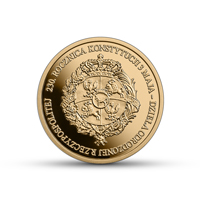
Nominał 100 zł … metal: Au 900/1000; stempel: lustrzany;
średnica: 21,00 mm; masa: 8,00 g; brzeg (bok): gładki;
nakład: do 1200 szt.; Projektant: Dobrochna Surajewska.
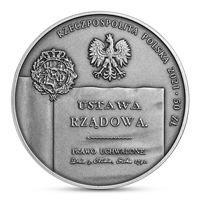
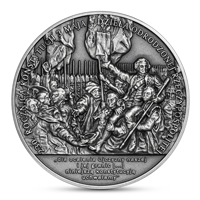
Nominał 50 zł … metal: Ag 999/1000; stempel: zwykły (oksyda); średnica: 45,00 mm; masa: 62,20 g; brzeg (bok): napis: 1791; nakład: do 6000 szt.; Projektant: Dominika Karpińska-Kopiec; Emitent: NBP; Na zlecenie NBP monety wyprodukowała Mennica Polska S.A. Wizerunek fragmentu obrazu Jana Matejki Konstytucja 3 maja 1791 roku, ze zbiorów Zamku Królewskiego w Warszawie – Muzeum, fot. Andrzej Ring, Lech Sandzewicz.
Rzeczpospolita była uzależniona od Rosji od początku XVIII w., ale społeczeństwo, odrodzone dzięki Komisji Edukacji Narodowej, Szkole Rycerskiej i zreformowanym kolegiom zakonnym, coraz trudniej godziło się z brutalną rosyjską ingerencją w życie kraju. Wybuch wojny rosyjsko-tureckiej (1787) wzbudził nadzieje, że Katarzyna II będzie musiała osłabić dławiącą Rzeczpospolitą uwięź. W takiej sytuacji zebrał się skonfederowany, a więc nienarażony na weto sejm lat 1788– 1792, który przeszedł do historii jako Sejm Czteroletni lub Wielki – z racji swych dokonań. Ich zwieńczeniem miała się stać nowoczesna konstytucja. Gdy sejm odrzucił jej nieudaną wersję pióra przywódcy obozu reform Ignacego Potockiego, ten poprosił o przygotowanie projektu Stanisława Augusta.
Tekst monarchy od stycznia 1791 r. omawiano w najgłębszej tajemnicy w gronie współtwórców ustawy: oprócz króla oraz Potockiego byli to Hugo Kołłątaj i sekretarz władcy Scipione Piattoli. Z ostateczną wersją zapoznano najpierw krąg zaufanych, a 3 maja przedstawiono ją w sejmie; część posłów, których opozycji się obawiano, nie wróciła jeszcze do Warszawy z wielkanocnej przerwy. Konstytucję przyjęto w drodze „zamachu stanu”, ale w lutym 1792 r. zaaprobowało ją ponad 90% sejmików w ogólnokrajowym referendum trzeciomajowym. Ustawa Rządowa 3 maja deklarowała suwerenność narodu i monteskiuszowski trójpodział władz, usuwała liberum veto i ustanawiała tron dziedziczny, a dopuszczając mieszczan do współdecydowania, rozszerzała bazę społeczną ustroju. Rzeczpospolita stała się nowoczesną monarchią konstytucyjną i zaczęła odzyskiwać prestiż w Europie.
Interwencja rosyjska w maju 1792 r. i przegrana przez nas wojna przyniosły upadek dzieła 3 maja, a potem polskiej państwowości. Konstytucja stanowiła jednak dowód, iż „wolni od hańbiących obcej przemocy nakazów” potrafiliśmy odrodzić państwo. Przywróciło to Polakom szacunek dla siebie i dla własnej tradycji. Pamięć o majowych dokonaniach przyświecała walce o odzyskanie niepodległej ojczyzny. Na rewersie monety złotej znajduje się herb Królestwa Polskiego (tak brzmiała oficjalna nazwa państwa) z czasów Stanisława Augusta: pod koroną królewską Orzeł Biały (herb Korony Polskiej), Pogoń (herb Wielkiego Księstwa Litewskiego) i Ciołek (herb Poniatowskich). Widoczna wstęga z dewizą: Pro fide, lege et grege (Za wiarę, prawo i naród). U dołu krzyż najwyższego odznaczenia państwowego – Orderu Orła Białego.
Na rewersie monety srebrnej fragment obrazu Jana Matejki Konstytucja 3 maja 1791 roku. Na pierwszym planie niesiony przez posłów marszałek Sejmu Czteroletniego Stanisław Małachowski, trzymający w ręku tekst Ustawy Rządowej 3 maja. Poniżej fragment preambuły konstytucji. W rękopiśmiennym oryginale cytowany tekst zawiera słowa „niniejszą konstytucyję”, natomiast w starodrukach z 1791 r. mamy formę „niniejszą konstytucyją”. Zdecydowano się umieścić na monecie tę ostatnią wersję jako frazę bardziej typową dla epoki. Na awersie monety srebrnej górna część karty tytułowej jednego z wczesnych druków Konstytucji 3 maja wydanego w oficynie Michała Grölla w Warszawie oraz herb Królestwa Polskiego z 1791 r. Informacja: Prof. Zofia Zielińska.

230th Anniversary of the Constitution of 3 May 1791
– the magnum opus of the revived Polish –
Lithuanian Commonwealth
www.nbp.pl
Narodowy Bank Polski is the central bank of the State, responsible for its monetary policy and price stability. The Bank’s functions are described in the Constitution of the Republic of Poland and the Act on NBP. NBP holds the exclusive right to issue the currency of the Republic of Poland. As the central bank, it does not provide accounts for the general public, accept deposits from or extend loans to individuals. It acts as a banker to the State budget and public sector entities. NBP also holds and manages the foreign exchange reserves of the State. Finally, it functions as a banker to banks, creating conditions for the operation of the Polish banking system. Narodowy Bank Polski is one of the most important research and analytical centres in the fields of economics and financial markets. On 28 April 2021, Narodowy Bank Polski issued into circulation a silver coin with the face value of 50 złoty and a gold coin with the face value of 100 złoty – “230th Anniversary of the Constitution of 3 May 1791 – the magnum opus of the revived Polish-Lithuanian Commonwealth”.


Face value: 100 zł … Metal: Au 900/1000; Finish: proof;
Diameter: 21.00 mm; Weight: 8.00 g; Edge (side): plain;
Mintage: up to 1,200 pcs; Designer: Dobrochna Surajewska.


Face value: 50 zł … Metal: Ag 999/1000; Finish: standard (oxidized); Diameter: 45.00 mm; Weight: 62.20 g; Edge (side): inscription: 1791; Mintage: up to 6,000 pcs; Designer: Dominika Karpińska-Kopiec; Issuer: NBP; The coins, commissioned by NBP, were struck by Mennica Polska S.A. Image of a fragment of the painting Constitution of 3 May 1791 by Jan Matejko, from the collection of the Royal Castle in Warsaw Museum, photograph by Andrzej Ring and Lech Sandzewicz.
The Commonwealth was dependent on Russia from the beginning of the 18th century, but its society, which was revived thanks to the Commission of National Education, the Corps of Cadets and modernised monastic schools, found it increasingly difficult to come to terms with Russia’s brutal meddling in the country’s affairs. The outbreak of the Russo-Turkish war (1787) raised hopes that Catherine II would have to loosen the leash choking the Commonwealth. In such circumstances, the Confederate Sejm, to which the privilege of liberum veto did not apply, assembled for the term from 1788 to 1792. This Sejm went down in history as the Four Years’ Sejm or Great Sejm due to its achievements, which culminated in a modern constitution. When the Sejm rejected an unsuccessful version penned by Ignacy Potocki, who was the leader of the reform camp, he asked Stanisław August to draw up a draft constitution. The monarch’s text was discussed from January 1791 amid the utmost secrecy by the co-authors of the act, who – apart from the king and Ignacy Potocki – included Hugo Kołłątaj and the ruler’s secretary, Scipione Piattoli. The final version was first introduced to a circle of trusted individuals, and on 3 May it was presented to the Sejm. Some of the deputies, whose opposition was feared, were still not back in Warsaw from the Easter break at that time.
The Constitution was adopted through a “coup d’état”, but in February 1792, it was approved by more than 90% of the Sejmiks in the nationwide 3 May referendum. The Government Act of 3 May proclaimed the sovereignty of the nation and implemented Montesquieu’s tripartite division of power. It abolished the liberum veto and established hereditary succession to the throne, and by granting townspeople the power of co-decision it broadened the social base of the system. The Commonwealth became a modern constitutional monarchy and began to regain its prestige in Europe. Russia’s intervention in May 1792 and the war lost by the Poles brought about the fall of the magnum opus of 3 May, and, eventually, Polish statehood. The constitution, however, proved that Poles – “free from the disgraceful orders imposed by foreign force” – were able to revive the state. It restored Polish people’s respect for themselves and for their own tradition.
The memory of the achievements of 3 May drove their fight to regain an independent homeland. The reverse of the gold coin features the coat of arms of the Kingdom of Poland (the official name of the state at the time) from the days of Stanisław August, consisting of the White Eagle under the regal crown (coat of arms of the Polish Crown), Vytis (coat of arms of the Grand Duchy of Lithuania), and Ciołek (coat of arms of the House of Poniatowski). A visible ribbon with the motto: Pro Fide, lege et grege, meaning: For faith, justice, and the nation. At the bottom, the cross of the highest state decoration – the Order of the White Eagle. The reverse of the silver coin features a fragment of the painting Constitution of 3 May 1791 by Jan Matejko. In the foreground, Stanisław Małachowski, Marshal of the Four Years’ Sejm, carried by the deputies and holding the text of the Government Act of 3 May. Below, a fragment of the Preamble to the Constitution. The obverse of the silver coin features a fragment of the title page of one of the earliest editions of the Constitution of 3 May published by Michał Gröll’s publishing house in Warsaw and the coat of arms of the Kingdom of Poland used in 1791. Info: Prof. Zofia Zielińska.


Insulin, 100th Anniversary:
PermanentTM domestic rate stamps
www.canadapost.ca
Mark the 100th Anniversary of this life-saving discovery with this booklet of 10 PermanentTM domestic rate stamps featuring an early insulin vial and a sample of Dr Frederick Banting’s notes. Insulin was discovered in 1921 by Frederick Banting, Charles Best, James Collip and John Macleod at the University of Toronto. For their work, Banting and Macleod were jointly awarded the 1923 Nobel Prize in Physiology or Medicine; they chose to share the prize money with Best and Collip.
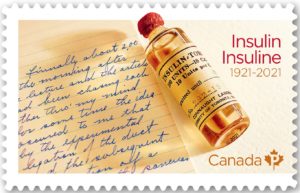
In 1934, Banting was knighted, becoming Sir Frederick Banting. Today, millions of people with diabetes continue to be treated with this life-saving drug. Canadian researchers have a long history of making critical advancements in medicine. Before the discovery of insulin, a person with Type 1 diabetes faced a death sentence. Insulin is considered one of the world’s most important medical discoveries and life-saving treatments and is one of Canada’s greatest contributions to medical research. Today, millions of people with diabetes continue to be treated with it. Stamp Value: PermanentTM (domestic rate); Stamp Designer: Subplot Design Inc.; Quantity Produced: 130,000; Dimensions: 40 mm by 25 mm; Issue Date: April 15, 2021.
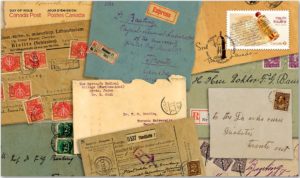
Insulin, 100th Anniversary: Official First Day Cover … Honour the 100th Anniversary of the discovery of the life-saving drug insulin with this Official First Day Cover. Its design featuring a collection of notes of gratitude sent to Dr Banting. Stamp Value: PermanentTM (domestic rate); Stamp Designer: Subplot Design Inc.; Quantity Produced: 7,000; Cancellation Site: Toronto ON; Issue Date: April 15, 2021.
On the brink of death from diabetes, 13-year-old Leonard Thompson was skeletal. The starvation diet he had been following – the only known treatment for diabetes in the early 20th century – had reduced him to less than 29 kilograms (65 pounds). As he lay in critical condition in Toronto General Hospital in January 1922, his father gave doctors permission to try an experimental drug developed by University of Toronto researchers that had never been injected into humans. Although Leonard had an adverse reaction to the initial formula, the second round of injections – administered after further refinements – saved his life. From these early trials came the medical breakthrough is now known as insulin. The diagnosis of diabetes was no longer considered a death sentence.
It was an early-morning epiphany that led Dr Frederick Banting to this life-saving discovery. The achievement was a team effort, with the surgical approach of Dr Banting, the critical input of research assistant Charles Best and visiting biochemist James Collip, and the advice, guidance, and oversight of John Macleod, chair of the Physiology Department. The discovery of insulin – which earned Banting and Macleod the 1923 Nobel Prize in Physiology or Medicine – has saved and improved the lives of countless people with diabetes over the past century.

Legends of Canadian Ballet –
Karen Kain: PermanentTM domestic rate stamps
www.canadapost.ca
Celebrate Canadian ballet legend Karen Kain with this booklet of 6 PermanentTM domestic rate stamps. The special stamp features a dramatic and dynamic black and white photo of Kain in performance, accented with metallic gold. Kain joined the Corps de Ballet of The National Ballet of Canada in 1969. She was quickly elevated to principal dancer of the company in 1971 after her debut as the Swan Queen in Swan Lake. Kain graced the stage for almost 30 years before retiring from dancing in 1997 – following a cross-country farewell tour. Karen Kain is recognized as one of the most gifted classical dancers of her era, Karen Kain (born in 1951 in Hamilton, Ontario) is one of Canada’s most renowned and committed leaders in the arts. Among her many awards and honours, Kain is a Companion of the Order of Canada, an Officier of France’s Ordre des Arts et des Lettres and a recipient of the Governor General’s Performing Arts Award for Lifetime Artistic Achievement.

Stamp Value: PermanentTM (domestic rate) … Stamp Design: Stéphane Huot; Stamp Image: Karen Kain – Andrew Oxenham; Quantity Produced: 150,000; Dimensions: 32 mm by 40 mm; Issue Date: April 29, 2021.

Legends of Canadian Ballet – Karen Kain: Official First Day Cover … Celebrate Canadian ballet legend Karen Kain with this Official First Day Cover. The stamp features a dramatic and dynamic black and white photo of Kain in performance, accented with metallic gold. The stamp is cancelled in Hamilton, Ontario. Kain joined the Corps de Ballet of The National Ballet of Canada in 1969. She was quickly elevated to principal dancer of the company in 1971 after her debut as the Swan Queen in Swan Lake. Kain graced the stage for almost 30 years before retiring from dancing in 1997 – following a cross-country farewell tour. Karen Kain is recognized as one of the most gifted classical dancers of her era, as well as one of Canada’s most renowned leaders in the arts. Among her many awards and honours, Kain is a Companion of the Order of Canada, an Officier of France’s Ordre des Arts et des Lettres and a recipient of the Governor General’s Performing Arts Award for Lifetime Artistic Achievement. Stamp Value: PermanentTM (domestic rate); Stamp Design: Stéphane Huot; Stamp Image: Karen Kain – Andrew Oxenham; Quantity Produced: 7,000; Cancellation Site: Hamilton ON; Issue Date: April 29, 2021.

Legends of Canadian Ballet: Souvenir sheet … Featuring both stamps from our Legends of Canadian Ballet issue, this souvenir sheet celebrates the work of Canadian ballet icons Karen Kain and Fernand Nault.
*** Karen Kain joined The National Ballet of Canada in 1969 and was quickly elevated to principal dancer of the company in 1971. She graced the stage for almost 30 years before retiring from dancing in 1997 – following a cross-country farewell tour. Kain is a Companion of the Order of Canada, an Officier of France’s Ordre des Arts et des Lettres and a recipient of the Governor General’s Performing Arts Award for Lifetime Artistic Achievement.
*** Born Fernand Noël Boissonneault in Montréal, Nault was a prominent dancer and choreographer – credited with raising the Grands Ballets Canadiens (now Grands Ballets Canadiens de Montréal) to international status. Nault was made an Officer of the Order of Canada, Chevalier of the Ordre national du Québec and received the Governor General’s Performing Arts Award for Lifetime Artistic Achievement.
Stamp Value: 2 x PermanentTM (domestic rate); Stamp Design: Stéphane Huot; Stamp Images: Fernand Nault – Bibliothèque de la danse Vincent-Warren; courtesy of the Fernand Nault estate; Karen Kain – Andrew Oxenham; Quantity Produced: 70,000; Dimensions: 123 mm by 90 mm; Issue Date: April 29, 2021.

Legends of Canadian Ballet –
Fernand Nault: PermanentTM domestic rate stamps
www.canadapost.ca
Celebrate the life and career of Fernand Nault (1920-2006) with this booklet of 6 PermanentTM domestic rate stamps The stamp features a dramatic and dynamic black and white photo of Nault in performance, accented with metallic gold. Born Fernand Noël Boissonneault in Montréal, Nault was a prominent dancer and choreographer who worked with the Grands Ballets Canadiens (now Grands Ballets Canadiens de Montréal) for more than 25 years and is credited with expanding the ballet’s repertoire, attracting renown and raising the dance company to international status. He was named Choreographer Emeritus of the Grands Ballets in 1990 – a title he held until his death. Among his many awards and accolades, Nault was made an Officer of the Order of Canada, Chevalier of the Ordre national du Québec and received the Governor General’s Performing Arts Award for Lifetime Artistic Achievement.
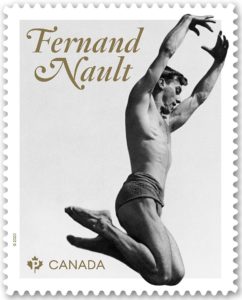
Stamp Value: PermanentTM (domestic rate); Stamp Design: Stéphane Huot; Stamp Image: Fernand Nault – Bibliothèque de la danse Vincent-Warren; courtesy of the Fernand Nault estate; Quantity Produced: 130,000; Dimensions: 32 mm by 40 mm; Issue Date: April 29, 2021.
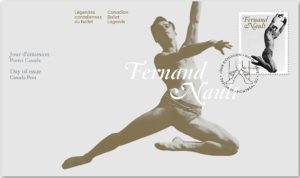
Legends of Canadian Ballet – Fernand Nault: Official First Day Cover … Celebrate the life and career of Fernand Nault (1920-2006) with this Official First Day Cover. The stamp features a dramatic and dynamic black and white photo of Nault in performance, accented with metallic gold. The stamp is cancelled in Montréal, Québec. Born Fernand Noël Boissonneault in Montréal, Nault was a prominent dancer and choreographer who worked with the Grands Ballets Canadiens (now Grands Ballets Canadiens de Montréal) for more than 25 years and is credited with expanding the ballet’s repertoire, attracting renown and raising the dance company to international status. He was named Choreographer Emeritus of the Grands Ballets in 1990 – a title he held until his death. Among his many awards and accolades, Nault was made an Officer of the Order of Canada, Chevalier of the Ordre national du Québec, and received the Governor General’s Performing Arts Award for Lifetime Artistic Achievement. Stamp Value: PermanentTM (domestic rate); Stamp Design: Stéphane Huot; Stamp Image: Fernand Nault – Bibliothèque de la danse Vincent-Warren; courtesy of the Fernand Nault estate; Quantity Produced: 7,000; Cancellation Site: Montréal QC; Issue Date: April 29, 2021.


2021 … $100 Pure Silver Coin –
Canada’s Provincial and Territorial Flags
www.mint.ca www.canadapost.ca
This 10 oz. the pure silver coin is the perfect way to show your national pride! On the coin’s reverse, the map of Canada gives shape to an eye-catching collage of provincial and territorial flags. From east to west and across our north, each flag is distinguished by colours and symbols specific to the land, people and history they represent. These 13 flags come together beautifully on this special collectable, where they form an inspiring image that proudly represents Canada as a whole.

Face value: $100 dollars … Composition: 99.99% pure silver;
Mintage: 750; Finish: proof; Weight: 311.54 g;
Diameter: 76.25 mm; Edge: serrated; Certificate: serialized;
Artist: Royal Canadian Mint engravers (reverse),
Susanna Blunt (obverse).
Design: Your coin’s reverse re-imagines the map of Canada as a colourful collage of the nation’s provincial and territorial flags. Each flag fills the shape of the province or territory it represents Yukon, Northwest Territories and Nunavut in the north; and from west to east, British Columbia, Alberta, Saskatchewan, Manitoba, Ontario, Quebec, New Brunswick, Prince Edward Island, Nova Scotia, and Newfoundland and Labrador. The reverse includes the year “2021”, the word “CANADA” and the face value “100 DOLLARS”. The obverse features the effigy of Her Majesty Queen Elizabeth II by Susanna Blunt.
Did you know? … *** Most of these provincial and territorial flags were formally adopted in the 1960s and 1970s, and many were inspired by the province/territory’s coat of arms. For example, the flags of Ontario and Manitoba are both based on the Canadian Red Ensign, which represented Canada prior to the adoption of the maple leaf flag in 1965; However, the two flags are differentiated by the provincial shield: Manitoba’s shield features a bison while Ontario’s shield has three maple leaves. *** The “youngest” flag in this collage is the flag of Nunavut. The flag was granted on April 1, 1999, the same day Nunavut was officially established.

2021 … $5 Pure Silver Coin –
Moments to Hold: Arms of Canada
www.mint.ca www.canadapost.ca
Celebrate the 100th Anniversary of the Arms of Canada with this 99.99% pure silver coin, part of the four-coin 2021 Moments to Hold compilation. In 1921, our nation was assigned its most distinguished emblem: the Arms of Canada. Few symbols or icons carry as much historic and symbolic weight as our armorial bearings, for even on its centennial, Canada’s coat of arms remains a timeless symbol of sovereignty, of tradition. It inspires pride by reminding us of our identity and history wherever the emblem appears, from passports to proclamations, and now, on this pure silver coin. This coin’s reverse features the current design of the Canada Coat of Arms drawn by Cathy Bursey-Sabourin, Fraser Herald at the Canadian Heraldic Authority. The obverse features the effigy of Her Majesty Queen Elizabeth II by Susanna Blunt.

Face value: 5 dollars … Composition: 99.99% pure silver;
Mintage: 100,000; Finish: Modified specimen;
Weight: 7.96 g; Diameter: 27 mm; Edge: serrated;
Artist: Cathy Bursey Sabourin (reverse),
Susanna Blunt (obverse).
Design: Your coin’s reverse features the current design of the Canada Coat of Arms drawn by Cathy Bursey-Sabourin, Fraser Herald at the Canadian Heraldic Authority. The obverse features the effigy of Her Majesty Queen Elizabeth II by Susanna Blunt. “I am proud to be Canadian. This collection, beginning with the Coat of Arms, is a reminder of our proud heritage, as well as the moments that have defined us.” Libby Sim, Product Manager.
Did you know… *** This emblem is commonly referred to as the Arms of Canada. Did you know it is actually The Queen’s coat of arms for use in Canada, more formally referred to as the Armorial Bearings of Her Majesty The Queen in Right of Canada? *** It has been modified three times since 1921. *** In 1923, the Government of Canada requested a painting from the College of Arms. This was the design used for governmental purposes until 1957. *** Alan Beddoe, a heraldic designer and artist, re-drew the Arms in 1957 to feature a modified Royal Crown that resembled St. Edward’s Crown, and in the shield, a sprig of red maple leaves. *** The current design was drawn by Cathy Bursey-Sabourin, Fraser Herald at the Canadian Heraldic Authority, and was approved in 1994. It includes an annulus behind the shield bearing the motto of the Order of Canada, Desiderantes Meliorem Patriam (“They desire a better country”). *** This isn’t the first coin to feature the Arms of Canada. Different versions have appeared on nearly every 50-cent coin issued since 1937.

2021 … Pure Silver Coin –
“W” Mint Mark: Silver Maple Leaf (Winnipeg)
www.mint.ca www.canadapost.ca
Back by popular demand! For 2020, our Ottawa and Winnipeg facilities joined forces to create the first-ever “Made in Manitoba” tribute to our beloved Silver Maple Leaf (SML) bullion coin. It was the first pure silver numismatic coin struck at our Winnipeg facility, and its distinctive “W” mintmark and burnished (matte) finish set it apart. You’ll find the same Silver Maple Leaf design and “W” mint mark on this 2021 fine silver collectable, but with a new coin finish that was inspired by our Winnipeg facility’s striking exterior. A “made in Manitoba” Silver Maple Leaf with a new tailored specimen finish.
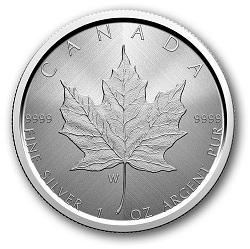
Face value: 5 dollars … Composition: 99.99% pure silver;
Mintage: 8,000; Finish: tailored specimen; Weight: 31.39 g;
Diameter: 38 mm; Edge: serrated; Certificate: serialized;
Artist: Walter Ott (reverse), Susanna Blunt (obverse).
Design: Your coin’s reverse features the iconic maple leaf from our first bullion coin, the 1979 Gold Maple Leaf bullion coin designed by Master Engraver Walter Ott; to this day, the design remains in use on all Maple Leaf bullion coins. The reverse features a “W” mint mark to the left of the leaf stem, indicating that this numismatic coin was struck at our Winnipeg facility rather than in Ottawa, where our numismatic coins are typically struck. On both the reverse and obverse, the coin’s tailored specimen finish was inspired by our Winnipeg facility’s striking exterior, with straight lines in the background meeting on an angle in the centre. The obverse includes the effigy of Her Majesty Queen Elizabeth II by Susanna Blunt.
Did you know? … When the Silver Maple Leaf bullion coin was introduced in 1988, it immediately set a new standard as the world’s first 99.99% pure silver bullion coin. It bears the same reverse design as the Gold Maple Leaf—a highly recognizable image created by Master Engraver Walter Ott.

2021 … $20 Pure Gold Coin –
100th Anniversary of Canada’s Coat of Arms
www.mint.ca
Features the original design! The coat of arms created for Canada in 1921 is re-created in extraordinary detail on this 99.99% pure gold coin, which was struck on an innovative thin, wide blank. These are the Arms that, a century ago, were an expression of the Dominion of Canada’s newfound sense of self; and today, they are a symbol of nationhood that proudly recounts our history and our journey together.
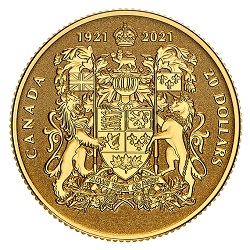
Face value: 20 dollars … Composition: 99.99% pure gold;
Mintage: 3,000; Finish: reverse proof; Weight: 3.14 g;
Diameter: 20 mm; Edge: serrated; Certificate: serialized;
Artist: RCM engravers reproduced the 1921
Coat of Arms (reverse), Susanna Blunt (obverse).
Design: Your coin’s reverse features a detailed reproduction of the original Arms of Canada proclaimed by King George V on November 21, 1921. At the base of the Coat of Arms is a garland of floral emblems—the English rose, the Scottish thistle, the Irish shamrock and the French lily—and a scroll bearing the motto “A MARI USQUE AD MARE” (“From sea to sea”). At the centre is the shield; its upper quadrants feature the three lions of England, the lion of Scotland, the Irish harp of Tara and the fleurs-de-lis of Royal France, while the bottom portion features a sprig of three maple leaves. The supporters are based on those of the Royal Arms of the United Kingdom: to the left of the shield, the lion of England holds the Royal Union Flag, while on the right, the unicorn of Scotland carries the flag of Royal France. Above the shield is the royal helmet draped with mantling. Atop the royal helmet is the crest set on a wreath of twisted cloth and is comprised of a crowned lion holding a maple leaf in its right paw. Above the crest is the imperial crown that represents the monarch as Canada’s Head of State. The reverse also features the engraved word “CANADA,” the commemorative dates “1921 – 2021”, and the face value, “20 DOLLARS”. The obverse features the effigy of Her Majesty Queen Elizabeth II by Susanna Blunt.
Did you know? *** The official rendition of Canada’s coat of arms has been revised three times since 1921: in 1923 when the Arms were slightly modified in style; in 1957, when the Arms were re-drawn to feature a modified Royal Crown and a sprig of red maple leaves in the shield; and in 1994, when an annulus bearing the motto of the Order of Canada, Desiderantes Meliorem Patriam (“They desire a better country”), was added behind the shield. *** You could have your very own heraldic emblem! All Canadian citizens, municipalities and organizations are welcome to contact the Canadian Heraldic Authority to request the creation of their own heraldic emblem, whether it’s a coat of arms, flag or badge. As part of the Canadian Honours System, heraldic emblems are granted in recognition of service to the community.

2021 … $50 Pure Silver Coin –
Lost Then Found: Champlain and the Astrolabe
www.mint.ca www.canadapost.ca
Discover the fascinating tale of the 17th-century mariner’s astrolabe! Found near Cobden, Ontario in 1867, the astrolabe, popularly associated with the French explorer-cartographer, Samuel de Champlain, is the inspiration for this extraordinary 5 oz. pure silver coin. The coin’s reverse features a small-scale reproduction of the lost-then-found astrolabe, cast in silver and bronze plated fixed atop Samuel de Champlain’s map of New France (1632). The astrolabe’s graduated scale encircles the map, which has been re-created using a mix of traditional and laser engraving that gets all the details right. The obverse features the effigy of Her Majesty Queen Elizabeth II by Susanna Blunt.
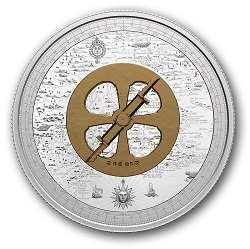
Face value: 50 dollars … Composition: 99.99% pure silver;
Mintage: 1,000; Finish: proof; Weight: 157.6 g;
Diameter: 65.25 mm; Edge: serrated; Certificate: serialized;
Artist: RCM engravers (reverse), Susanna Blunt (obverse).
The tale of the 17th-century mariner’s astrolabe found near Cobden, Ontario, is the inspiration for this 5 oz. pure silver coin. Its reverse features a small-scale reproduction of the lost-then-found astrolabe, cast in silver and bronze plated fixed atop Samuel de Champlain’s map of New France (1632). The astrolabe’s graduated scale encircles the map, which has been re-created using a mix of traditional and laser engraving that gets all the details right. The end result is a design that perfectly channels the spirit of the era in which the astrolabe was made, used… and lost!
Design: The reverse design features a reproduction of the 17th-century mariner’s astrolabe found near Cobden, Ontario, and popularly associated with French explorer-cartographer Samuel de Champlain. Used to determine latitude, the navigational tool-turned-treasure is cast in silver and bronze plated on this coin; it is backed by an engraved reproduction of Champlain’s hand-drawn map of New France (1632), which is framed by the astrolabe’s graduated scale. The obverse features the effigy of Her Majesty Queen Elizabeth II by Susanna Blunt.
Did you know? … *** Champlain’s “lost” astrolabe. This idea sprang forth in the 19th century after the astrolabe’s discovery, but Champlain’s detailed account of his 1613 expedition up the Ottawa River contains no mention of a lost navigational instrument. Nevertheless, the mariner’s astrolabe bears the date “1603” and lay on a rare portage route used by Champlain; the French explorer would have used an astrolabe in his many voyages at sea and while charting the coasts and waterways of eastern Canada. Another theory holds that the astrolabe could have belonged to missionaries or other travellers who used the same route as Champlain.
*** The astrolabe was found in August 1867. A 14-year-old boy was helping his father clear trees on the shores of Green Lake (now Astrolabe Lake) near Cobden, Ontario when he unearthed a brass “disk.” It was sold to a steamboat captain for $10, and the mariner’s astrolabe passed through several hands before landing in a New York collection. In June 1989, the Canadian government acquired it and conferred it to the Canadian Museum of Civilization (now the Canadian Museum of History), where it proudly resides.
*** The astrolabe is missing a piece. The Cobden astrolabe is the smallest of the surviving 17th-century mariner´s astrolabes and is in excellent condition, except for one missing piece: a small ring to which a weight would be attached in order to steady the instrument. The ring was still intact in an 1879 photograph, so it likely broke off in the late 19th century.
*** A mariner’s astrolabe is a simplified astrolabe. Made of brass or bronze, it was designed for use at sea; its four windows allowed the breezes to pass through while the weight at the bottom kept it steady. It was a common navigational instrument in the 16th and 17th centuries, but only a hundred or so exist today — including the famous one highlighted on this coin.
*** Of the 100 astrolabes that have survived to this day, at least five are known to be in Canada. They include: a Spanish astrolabe (ca. 1565-1600) found in Red Bay, N.L. and held by Parks Canada; the Cobden astrolabe (1603) presumably made in Honfleur, France, and represented on this coin; two astrolabes – a French one (1617) and a Portuguese one (1638) – discovered at Isle-aux-Morts, N.L. and held at The Rooms in St. John’s, N.L.; and a Portuguese one (1632) preserved at the Sulpician Vieux Séminaire in Old Montreal. Another astrolabe (1593) discovered in Cuba by a team of Canadian underwater treasure hunters likely resides in a private collection in Canada.

2021 … Royal Celebration Set
www.mint.ca www.canadapost.ca
In honour of Her Majesty Queen Elizabeth II’s 95th birthday, the Royal Canadian Mint and The Royal Mint are pleased to present this two-coin set that celebrates our shared sovereign. The set features two 1 oz. pure silver coins with a proof finish: a $20 Fine Silver Coin from the Royal Canadian Mint and a £2 Silver Proof Coin from The Royal Mint.
The Queen Elizabeth II Monument: The world’s first equestrian statue of Her Majesty Queen Elizabeth II was created by Vancouver sculptor Jack Harman (1927-2001) and required a team of 10 sculptors to complete. Cast in bronze and set atop a granite base, the monument commemorates the 125th anniversary of Confederation (1992) and the 40th anniversary of Her Majesty’s reign. It was unveiled on Parliament Hill on July 1, 1992, during Her Majesty’s visit, but the 10-year rehabilitation of the Centre Block building on Parliament Hill necessitated a temporary relocation in 2019. The monument is now located in front of the main gate of Rideau Hall, the official Canadian residence of Her Majesty and her representative, the Governor-General of Canada.

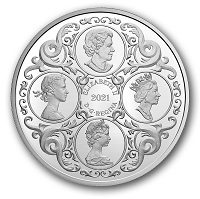
2021 … $20 Fine Silver Coin – The Queen Elizabeth II Equestrian Monument … Denomination: $20 CAD; Composition: 99.99% pure silver; Weight: 31.39 g; Diameter: 38 mm; Finish: Proof; Edge: Serrated; Mintage (quantity produced): 6,500; Artist: reverse designers: Royal Canadian Mint Engravers/Jack Harman, obverse designers: The 2003-present effigy by Susanna Blunt; the 1990-2002 effigy by Dora de Pédery-Hunt; the 1965-1989 effigy by Arnold Machin; and the 1953-1964 effigy by Mary Gillick; Mint: Royal Canadian Mint; Country of Issue: Canada.
Coin design: The Royal Canadian Mint reverse design features The Queen Elizabeth II Equestrian Monument by sculptor Jack Harman (1927-2001). It depicts Her Majesty riding astride her horse, Centennial. The statue was unveiled by Her Majesty on July 1, 1992, on Parliament Hill in Ottawa, Canada. The obverse features ornamental flourishes and the four effigies of Her Majesty that have appeared on Canadian coins since 1953 (clockwise from the top): the effigy by Susanna Blunt (2003-present); the 1990-2002 effigy by Dora de Pédery-Hunt; the 1965-1989 effigy by Arnold Machin; and the 1953-1964 effigy by Mary Gillick.
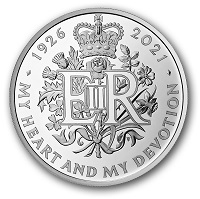
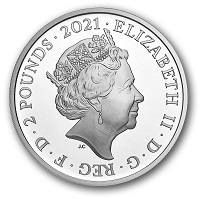
2021 … £2 Silver Proof Coin – The 95th Birthday of Her Majesty The Queen … Denomination: £2 GBP; Composition: 99.9% pure silver; Weight: 31.21 g; Diameter: 38.61 mm; Finish: Proof; Edge: Milled; Mintage (quantity produced): 6,500; Artist: reverse designer: Timothy Noad, obverse designer: Jody Clark; Mint: The Royal Mint; Country of Issue: United Kingdom.
Coin design: The Royal Mint coin reverse features a symbolic design by British heraldic artist, Timothy Noad. Behind the Royal Cypher, The Queen’s royal heritage and symbols of the British nations are represented by a posy filled with thistles, daffodils, roses and shamrocks. The reverse also bears the inscription, “MY HEART AND MY DEVOTION”, referencing a promise The Queen made in her 1957 Christmas speech and has kept ever since. The obverse features the effigy portrait of Her Majesty The Queen by Jody Clark.


CAPEX 22 International One Frame Stamp Championship Exhibition will be held June 9-12, 2022 at the Metro Toronto Convention Centre (MTCC) in the heart of Toronto’s downtown entertainment district. With 400+ frames, CAPEX 22 will be the largest showing of one-frame exhibits at any exhibition, ever.

The exhibition will also have a wonderful array of philatelic literature exhibits both in traditional print format and with four categories of digital literature including philatelic websites. The exhibition’s bourse area will consist of more than 75 Canadian and International dealers, providing a full range of philatelic material for exhibition attendees. CAPEX 22 is being held under the patronage of the Federacion Interamericana de Filatelia (FIAF) and with the recognition of Federation Internationale de Philatélie (FIP).

Exhibition attendees may attend special seminars and other specialist society presentations of interest throughout the four days. Maresch will hold a major auction during the exhibition. The NTSC has booked a meeting room for a presentation during CAPEX 22, and we will share the details closer to the show. Collectors may choose to pre-register for the full four days; daily admissions will also be made available. Registration program information will soon be announced. Feel free to visit the CAPEX 22 website regularly ( www.capex22.org ) to keep up-to-date with all the developments.


www.gtapa.org
The GTAPA is committed to promote
and stimulate the art of philately to all ages for fun,
culture, education, and friendship.
